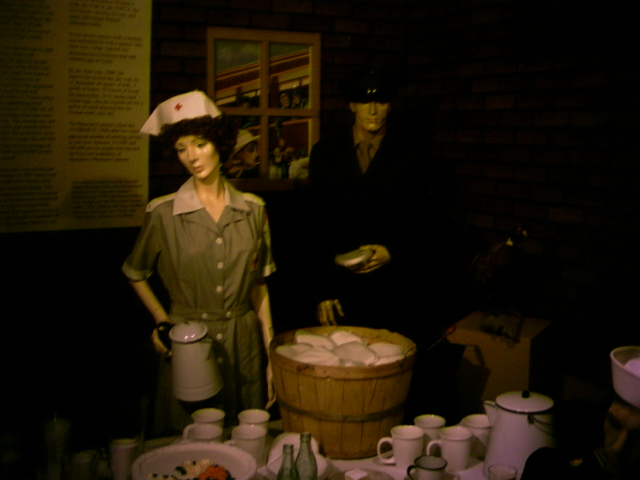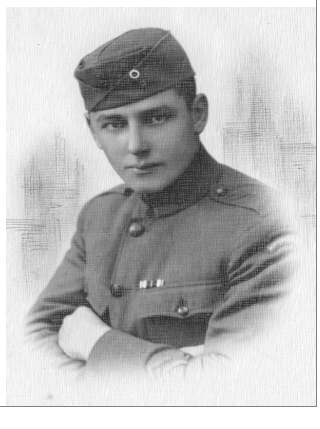History
- Aberdeen SD &
Sidney
L Smith, Post #24
Like most towns in the great
plains, Aberdeen was started as a railroad town. Charles H Prior, the town
site agent for the Chicago, Milwaukee, and St Paul railroad filed the first
papers at the land office in Watertown, part of the Dakota Territory, for
a town to be located at the spot where his employer's rail line was expected
to intersect the Chicago Northwestern's proposed line. Alexander Mitchell,
president of the Chicago, Milwaukee, & St Paul, named the town-to-be
Aberdeen, after his own hometown in Scotland. The first plat of land was
deeded on the 3rd of January, 1881 and the first train arrived July 6th with
the post office established that August. In 1885, Aberdeen was named the
Seat of Brown County.
The railroad continued to
play a large role in the growth of Aberdeen, after the initial two lines
met in 1881, seven more were added so that by 1906 nine sets of tracks lead
into what would become known as the Hub City; four lines for the Chicago,
Milwaukee, & St Paul, two lines for the Chicago Northwestern, one line
for the Great Northern, and two lines for the Minneapolis & St Louis.
The convergence of rail lines
made Aberdeen a natural stopping point for military troop trains; starting
when South Dakota's First Infantry Regiment was welcomed home here by President
McKinely in October of 1899 after returning from duty under General McArthur
in the Philippines during the Spanish American War. The rail lines also
played a vital role in delivering recruits to the US Army in both World Wars,
and when the USO and Red Cross built a canteen in the Milwaukee Rail depot
in 1943, they couldn't have known that it would become one of Aberdeen's
most memorable locations.
From it's opening on the
14th of Aug until just before Christmas, the canteen provided over 150,000
free meals to troops passing through the station; a remarkable endeavor,
but the real history was still to come.
 Local farmers, still eager to contribute to the canteen despite being
well past the harvest season, donated pheasants from recent hunts to the
canteen and started a trend that would lead to the canteen becoming unofficially
renamed the "Pheasant Canteen". With an average of over 500 soldiers per
day traveling through the depot, the Pheasant Canteen continued to give a
free meal to every serviceman, highlighted by the now famous pheasant sandwiches.
Any soldier arriving at the depot on their birthday would also receive a
special cake, and there was a decorated tree each Christmas and colored eggs
each Easter. When the Pheasant Canteen closed on the 31st of March, 1946,
between 510,000 and 600,000 servicemen had been feed, all at no cost to themselves
or the military. Every meal was donated by the residents of Aberdeen and
40 other towns within a 75 mile radius.
Local farmers, still eager to contribute to the canteen despite being
well past the harvest season, donated pheasants from recent hunts to the
canteen and started a trend that would lead to the canteen becoming unofficially
renamed the "Pheasant Canteen". With an average of over 500 soldiers per
day traveling through the depot, the Pheasant Canteen continued to give a
free meal to every serviceman, highlighted by the now famous pheasant sandwiches.
Any soldier arriving at the depot on their birthday would also receive a
special cake, and there was a decorated tree each Christmas and colored eggs
each Easter. When the Pheasant Canteen closed on the 31st of March, 1946,
between 510,000 and 600,000 servicemen had been feed, all at no cost to themselves
or the military. Every meal was donated by the residents of Aberdeen and
40 other towns within a 75 mile radius.
Of course, support for the
serviceman was nothing new to the Aberdeen area.
The VFW had formed a presence
here as early as 1903 (fourth oldest continuously active post), and The
American Legion followed 1919 when the call first went out to constitute
posts. By 1921 the American Legion was running their own veterans employment
program in the city, and had a theatrical troupe that performed annual plays
at the local theater, along with a post band.
The post chose the name of
Sidney L Smith, in honor of Private First Class Smith who was killed in
action while serving as a dispatch runner in Soissons France, July 20th
1918 as part of Co. L, 18th U.S. Infantry, 1st Div.
 While born in Canton, Il (1896) and having gone to military school in
Roswell, NM, Sidney L Smith had moved to Aberdeen in 1915 and had joined
the military as part of the South Dakota national guard. He was stationed
at Camp Pontis in Mobridge, SD when he transferred to the 148th Machine
Gun Battalion. He later transferred again to the 1st Infantry
Division, 18th Brigade, Company L where he saw action at the
Battle of Cantigny, and was in the trenches for 70 days at Montdidier, France.
In Fosh's big drive, Smith's company took part in the battle of Chateau-Thierry,
and then Sessions, where he was listed as missing in action for 9 months
before Congressman Royal C. Johnson assisted the Red Cross' efforts to determine
his fate. Smith's status was changed from MIA and a telegram was sent to
his family from the adjutant general's office at Washington, DC, it reads
as follows:
While born in Canton, Il (1896) and having gone to military school in
Roswell, NM, Sidney L Smith had moved to Aberdeen in 1915 and had joined
the military as part of the South Dakota national guard. He was stationed
at Camp Pontis in Mobridge, SD when he transferred to the 148th Machine
Gun Battalion. He later transferred again to the 1st Infantry
Division, 18th Brigade, Company L where he saw action at the
Battle of Cantigny, and was in the trenches for 70 days at Montdidier, France.
In Fosh's big drive, Smith's company took part in the battle of Chateau-Thierry,
and then Sessions, where he was listed as missing in action for 9 months
before Congressman Royal C. Johnson assisted the Red Cross' efforts to determine
his fate. Smith's status was changed from MIA and a telegram was sent to
his family from the adjutant general's office at Washington, DC, it reads
as follows:
"Pvt. Sidney
L. Smith, Infantry previously reported severely wounded in action between
July 18 and July 24, now reported Killed in action July 20." [1918]
 Local farmers, still eager to contribute to the canteen despite being
well past the harvest season, donated pheasants from recent hunts to the
canteen and started a trend that would lead to the canteen becoming unofficially
renamed the "Pheasant Canteen". With an average of over 500 soldiers per
day traveling through the depot, the Pheasant Canteen continued to give a
free meal to every serviceman, highlighted by the now famous pheasant sandwiches.
Any soldier arriving at the depot on their birthday would also receive a
special cake, and there was a decorated tree each Christmas and colored eggs
each Easter. When the Pheasant Canteen closed on the 31st of March, 1946,
between 510,000 and 600,000 servicemen had been feed, all at no cost to themselves
or the military. Every meal was donated by the residents of Aberdeen and
40 other towns within a 75 mile radius.
Local farmers, still eager to contribute to the canteen despite being
well past the harvest season, donated pheasants from recent hunts to the
canteen and started a trend that would lead to the canteen becoming unofficially
renamed the "Pheasant Canteen". With an average of over 500 soldiers per
day traveling through the depot, the Pheasant Canteen continued to give a
free meal to every serviceman, highlighted by the now famous pheasant sandwiches.
Any soldier arriving at the depot on their birthday would also receive a
special cake, and there was a decorated tree each Christmas and colored eggs
each Easter. When the Pheasant Canteen closed on the 31st of March, 1946,
between 510,000 and 600,000 servicemen had been feed, all at no cost to themselves
or the military. Every meal was donated by the residents of Aberdeen and
40 other towns within a 75 mile radius. While born in Canton, Il (1896) and having gone to military school in
Roswell, NM, Sidney L Smith had moved to Aberdeen in 1915 and had joined
the military as part of the South Dakota national guard. He was stationed
at Camp Pontis in Mobridge, SD when he transferred to the 148th Machine
Gun Battalion. He later transferred again to the 1st Infantry
Division, 18th Brigade, Company L where he saw action at the
Battle of Cantigny, and was in the trenches for 70 days at Montdidier, France.
In Fosh's big drive, Smith's company took part in the battle of Chateau-Thierry,
and then Sessions, where he was listed as missing in action for 9 months
before Congressman Royal C. Johnson assisted the Red Cross' efforts to determine
his fate. Smith's status was changed from MIA and a telegram was sent to
his family from the adjutant general's office at Washington, DC, it reads
as follows:
While born in Canton, Il (1896) and having gone to military school in
Roswell, NM, Sidney L Smith had moved to Aberdeen in 1915 and had joined
the military as part of the South Dakota national guard. He was stationed
at Camp Pontis in Mobridge, SD when he transferred to the 148th Machine
Gun Battalion. He later transferred again to the 1st Infantry
Division, 18th Brigade, Company L where he saw action at the
Battle of Cantigny, and was in the trenches for 70 days at Montdidier, France.
In Fosh's big drive, Smith's company took part in the battle of Chateau-Thierry,
and then Sessions, where he was listed as missing in action for 9 months
before Congressman Royal C. Johnson assisted the Red Cross' efforts to determine
his fate. Smith's status was changed from MIA and a telegram was sent to
his family from the adjutant general's office at Washington, DC, it reads
as follows: